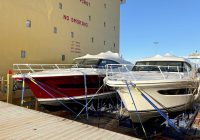OzFish Unlimited is calling on community volunteers to help make a difference by collecting water samples to assess the health of the Clarence River catchment area.

OzFish, Australia’s only recreational fishing charity dedicated to restoring waterways, has partnered with the NSW Department of Planning and Environment to launch a Water Quality Pilot Project.
The 12–week Clarence River Fisher Science Project will kick off in August 2023 and OzFish is looking for at least 20 volunteer citizen scientists to collect water samples following rainfall throughout the catchment area from Yamba to Tabulum in the north, down to Coramba and Nymboida.
And the rallying cry for volunteers is not just being sent out to anglers – the river is used by canoeists, paddleboarders, jetski riders, waterskiers and all sorts of people who love the water. Anyone who can help will be most welcome.
Dr Shane White, OzFish Project Manager in the NSW North Coast said volunteers do not need to have experience, just be willing to donate a small amount of time have an interest in understanding water quality and a passion for healthy waterways.
“It’s super easy for the volunteers,” said Dr White. “We’ll give them all the training. They will basically have to drive to a location, lower a bucket with a rope over the side of a bridge or riverbank, collect some water, pull it up and then pour it inside a provided vial.
“Vollies then look inside the vial and read the numbers on the side and record the data.
“We want to hear not just from rec fishers but anyone generally concerned about the rivers and the health of the local environment. We’re casting a very wide net, pardon the pun.
“You don’t need a boat to do this project. You just need transport and to be able to use a bucket. It’s very simple.”
There will be a training seminar on August 17 so the volunteers can receive their testing kit and instructions on what’s required and when.

“We’re particularly interested to go out after rainfall events. We’re aiming for 20 volunteers to collect a water sample post-rain and then we’re going to test for turbidity at different spots on the river to give us a system-wide view,” said Ryan Lungu, OzFish Program Manager – NSW Coast.
“We’re making a breakthrough in terms of engaging recreational fishers in water quality monitoring . If it’s successful we could easily roll this out in other catchments.”
With its extensive catchment area of 22,716km², it is the largest coastal river catchment in New South Wales, but this vital waterway faces several challenges, including erosion, land use practices, nutrient inputs, acid sulphate soils, channel modifications and alterations to natural flows.
Considering the significance of the Clarence River to primary industries such as commercial fishing, beef cattle production and sugar cane, as well as the local community, there is a pressing need to address the health of this ecosystem, further exacerbated by the devastating flooding of 2022.
This pilot project will focus on the Clarence River and its tributaries, including Shark, Broadwater, and Sportsmans Creeks, as well as the Coldstream, Orara, Mann, and Esk Rivers.
“A lot of this is understanding where in the catchment erosion problems are happening, what’s running of the riverbank and into our rivers,” Dr White added.
“With all these tributaries coming down into the one big river, if you’re just looking at the one big river, you don’t know which one of these tributaries is contributing sediment into the river.

“It may be that there are only one or two that are the key problems. Once we can find that out and isolate those areas, we can start to ask the question ‘how can we fix them?’ and that can improve the health of the overall catchment.”
Water quality plays a crucial role in the survival and well-being of native fish and other aquatic life, influencing functions such as growth, reproduction and predator-prey interactions.
“Whenever it rains, the lower Clarence River turns a murky brown colour and you’d be lucky to see 10cm into the water,” Dr White said.
“What we can do from this is target priority work zones in this huge catchment, so we know where to do the work for erosion management, riparian restoration and habitat enhancement.”
Turbidity is the intensity of light transmitted through water, which indicates water quality, with high turbidity levels linked to suspended solids, algae, and organic nutrients.
“Turbidity is a measure of the amount of impurities in the water. That can be algae, soil, anything that’s microscopic size that stops the light getting through,” Dr White added.
“Increases in turbidity can kill seagrass and impact aquatic life, particularly organisms that live on the bottom of the river that need light to photosynthesise. It’s this primary productivity that is impacted by high turbidity, reducing the food and habitat available for other species.
“Parts of the Lower Clarence River have had up to 95% loss of seagrass since the beginning of records, due partly to the increase in turbidity but also things like pesticides and herbicides flowing off the farms.
“Seagrass is so important because it’s where a lot of the juvenile fish will spend most of their lives because they can hide in there and have access to food sources.”
Lungu added: “Clear water is always best in our rivers. The most pristine rivers are the ones that you can see the bottom of and that’s where everything is thriving.
“Anything that gets between the sun and the plants on the bottom is the problem.”
For more information visit ozfish.org.au
To keep up to date with all marine industry news visit www.marinebusinessnews.com.au








